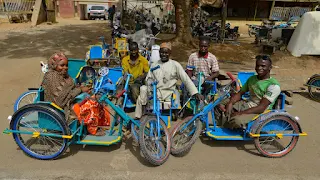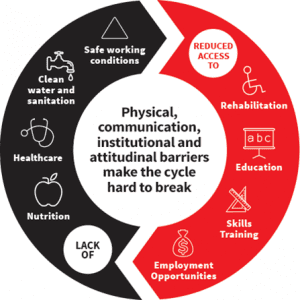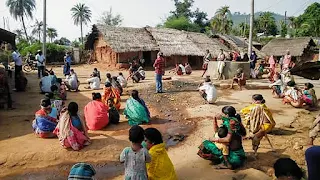Key points
- Do not assume that disability is visible. Seek to identify individuals with disabilities proactively, including those with psychosocial and intellectual disabilities.
- Consult persons with disabilities and their families to identify their needs and capacities and understand what barriers impede the effectiveness of protection and assistance programmes.
- Inclusive disability programming is not just about providing ramps and wheelchairs.
- Make sure the language you use to describe persons with disabilities respects their dignity and humanity. (Using the term ‘persons with a disability' rather than ‘the disabled' or ‘handicapped people while speaking to’).
- Consult persons with disabilities when you decide the content of food and non-food assistance packages, to ensure that distribution arrangements are accessible.
1Overview
The Convention on the Rights of Persons with Disabilities and its Optional Protocol (CRPD, 2006, A/RES/61/106) defines persons with disabilities to "include those who have long-term physical, mental, intellectual or sensory impairments which in interaction with various barriers may hinder their full and effective participation in society on an equal basis with others".In situations of forced displacement, persons with disabilities have the same rights and basic needs as others and face the same challenges. However, they face numerous additional barriers. They face particular protection risks, including a heightened risk of violence, exploitation and abuse, and high levels of stigma. They have difficulties accessing humanitarian assistance, education, livelihoods, health care and other services. They may be denied certain legal rights, and are often excluded from decision-making processes and leadership opportunities.
Persons with disabilities are not a homogenous group. They face multiple and compounding forms of discrimination, on the basis of disability but also on other grounds, which may lead to situations of exclusion.
The World Health Organization estimates that about 15% of the world's population has a disability. In situations of forced displacement, the incidence of disability is usually higher because a larger proportion of people have injuries, lack access to medical services, and face barriers in their environment.
2Protection objectives
- To identify and assess the needs of persons with disabilities, from the start of an emergency and throughout.
- To provide an immediate and adequate response to specific needs and ensure that protection and assistance programmes are accessible to persons with disabilities on an equal footing with other persons of concern.
- To create conditions in which people with disabilities do not suffer discrimination, and participate in decisions that affect them.
- To ensure that all responses take account of and include persons with disabilities, by applying an age, gender and diversity lens and considering their specific needs. Persons with disabilities must be enabled to participate as actors in the protection of their families and communities.
- To ensure that appropriate systems are in place during an emergency to prevent and respond to violence against persons with disabilities and their families, or their exploitation or abuse.
3Underlying principles and standards
UN Convention on the Rights of Persons with Disabilities and its Optional Protocol (2006).Article 11 of the CRPD refers to the safety and protection of persons with disabilities in conflict and emergency situations.
Handicap International, Disability Checklist for Emergency Response, 2010. In braille and large print.
UNHCR Executive Committee, Conclusion on refugees with disabilities and other persons with disabilities protected and assisted by UNHCR, 2010.
Reaffirms UNHCR's responsibility and commitment to upholding the rights of persons with disabilities in accordance with Executive Committee Conclusions, international conventions, and relevant United Nations General Assembly resolutions. Outlines recommended actions by UNHCR, its partners, and States.
UNHCR, Need to Know Guidance: Working with Persons with Disabilities in Forced Displacement, 2019.
Provides practical guidance on issues that must be considered to ensure that the rights of persons with disabilities of concern to UNHCR are fulfilled without discrimination.
UNHCR, Policy on Age, Gender and Diversity (AGD), 2018.
The policy reinforces UNHCR's commitment to ensure that people are at the centre of all we do. It consolidates commitments to a strong AGD orientation, accountability to affected people (AAP) and commitments to women and girls. It defines six areas of engagement and ten mandatory core actions for all UNHCR operations and headquarters.
4Protection Risks
- Persons with disabilities may experience difficulty in moving, hearing, seeing, communicating or learning. Their disabilities may include injuries or chronic illnesses.
- Persons with disabilities face a variety of barriers: these may be physical and environmental; attitudinal; policy; or in communication.
- Persons with disabilities are more likely to experience violence, including: sexual and domestic abuse; exploitation by family members; discrimination; and exclusion from access to humanitarian assistance, education, livelihoods, health care, a nationality, and other services. Women, older individuals, children, and LGBTI persons who have a disability are doubly exposed to such risks.
- Persons with disabilities are likely to be more at risk in dispersed rural and urban settings and recent displacement sites, because communities in these locations are less cohesive and community protection mechanisms may be weaker.
- Adolescents and youth with disabilities are frequently excluded from peer group activities and social networks that can help to protect them from violence, including sexual and gender-based violence (SGBV).
- Children with disabilities may suffer stigma, bullying or discrimination (including harassment) at the hands of their peers or teachers, harming their educational opportunities.
- Persons with psychosocial and intellectual disabilities tend to be less identifiable than persons with physical and sensory disabilities. As a result, programmes are less likely to address their needs and registration procedures are more likely to overlook them.
5Other risks
- Persons with disabilities will be particularly at risk if UNHCR or its partners fail to protect the security of populations of concern.
- The reputation of UNHCR and its partners will be put at risk if they do not fulfil their responsibility to protect all populations of concern
6Key decision points
- At the start of an emergency, consider disability when designing shelter and settlement options, selecting sites, planning and designing infrastructure, and setting access standards. Make sure that arrangements for emergency aid distribution address the access needs of persons with disabilities.
- Take immediate steps to ensure that the response deals adequately with the specific needs of persons with disabilities.
- Ensure that persons with disabilities are identified and registered and that their needs are assessed.
- Make sure that services and infrastructures take account of and include those with physical, hearing, visual, intellectual and psychosocial disabilities
- Establish referral systems to ensure that persons with disabilities reach relevant service providers.
- Put in place systems to prevent and respond to violence, exploitation and abuse.
- Ensure that programmes include persons with disabilities, and that persons with disabilities have access to information and messaging about programmes that concern them.
- Ensure that staff, partners and local and national authorities recognize and know how to respond to the specific needs of persons with disabilities.
- Ensure persons with disabilities can participate in protecting their families and communities.
- In non-camp settings, take steps to identify potential partners and establish an outreach programme, to ensure that persons with disabilities are identified and receive information they need.
7Key steps
Identification and assessment procedures- Assign community workers, UNHCR protection staff or community-based protection staff to (pre-)registration points or places of arrivals, to identify and register persons with disabilities.
- Integrate the Washington Group short set of disability questions or other relevant tools in data collection mechanisms to identify persons with disabilities.
- Appoint community workers or partners' staff to identify and register persons with disabilities who may not have been present at (pre-)registration. (This is often due to barriers at access registration points.) Persons with disabilities and their representative organisations may be useful sources of information.
- During rapid and participatory assessments, include specific questions about the experience of persons with disabilities. Do so to identify specific protection risks, specific needs, and barriers that prevent people from obtaining assistance,.
- Consult persons with disabilities to determine which referral mechanisms and which forms of assistance they find most appropriate and accessible.
- Train registration staff and provide guidance on how they should identify and record persons with disabilities who have not yet been registered in ProGres.
- Enter in ProGres the specific needs of persons with disabilities.
Access to services
- Identify families that include persons who have difficulty moving; in consultation with the families, locate them close to facilities and services when assigning plots and shelters.
- Train partners and local service providers in disability inclusion and build their capacity to implement it.
- In consultation with persons with disabilities, adapt medical centres, distribution sites, water sources, latrines, schools, shelters, and other infrastructure, to make them safe, accessible and appropriate for persons with disabilities. (Avoid barriers or tripping hazards, include ramp access, large doorways, handrails on stairs, space to turn a wheelchair, non-slippery floors, etc.).
- Ensure food and other distributions are accessible to persons with disabilities by establishing a distribution monitoring system. Where appropriate, consider separate queues, transport support, smaller parcels, or home delivery systems. Work with health and nutrition partners to identify specific dietary needs of persons with disabilities and people with chronic health issues.
- Consult persons with disabilities to identify what specific protection risks they face, and whether cash-based assistance programmes need to be adapted.
- Consult persons with disabilities when designing new infrastructures and deciding what items distributions should include (for example, lighter jerry cans). Consult early to avoid expensive adjustments later.
- Work with school authorities and communities to improve the inclusion of children with disabilities. Adapt education programmes where necessary. Include children and parents in consultation.
- Consult persons with disabilities to identify barriers they face in accessing health services. (Include public health, sexual and reproductive health, maternal and child health, etc.)
Support services
- Map service providers and potential partners (at community, local and national level, and camp level if applicable) who provide specialized services, such as rehabilitation and assistive devices. Check that their services can be accessed by refugees.
- In consultation with persons with disabilities, identify service providers, agree on coordination mechanisms, and establish referral mechanisms for access to services.
- Prioritize persons with disabilities in reunification efforts. Do not separate persons with disabilities from their family members or support persons, or from their assistive devices, adaptive aids, or medication (for example, during relocation or transport).
- Consult persons with disabilities and the wider community to assess the community's capacity to support persons with disabilities who are alone and need support.
- Identify persons with disabilities who are living in institutions, and ensure that protection staff and partners follow up.
Prevention of abuse and exploitation
- Ensure that all programmes to prevent and respond to sexual exploitation and abuse (PSEA) and sexual and gender-based violence (SGBV) include persons with disabilities.
- Through community workers and other partners, establish systems for monitoring and following up the situation of persons with disabilities who are at heightened risk of abuse or exploitation. Implement appropriate referral mechanisms.
- Train persons with disabilities, their families, SGBV prevention and response partners, and community workers, in how to recognize, prevent, and report instances of violence, exploitation and abuse.
Inclusion and information sharing
- Prepare all key messages to displaced populations in a variety of formats (radio, word of mouth, information booklets in ‘easy to read' format, texts with symbols and images, etc.).
- Make sure your methodologies for consultation include persons with disabilities and their households. Involve them in decision-making and programming, including the design, assessment, monitoring and evaluation of activities.
Awareness-raising and advocacy
- Inform staff and partners of the rights of persons with disabilities. Emphasize that responses need to be designed in consultation with persons with disabilities to ensure they are inclusive and accessible.
- Train UNHCR and partner staff on practical steps they can take to improve accessibility and inclusion. Local organizations of persons with disabilities can be an important training resource. Encourage the authorities to include persons of concern with disabilities in national policies and programmes, including national social protection programmes.
Participation
- Include persons with disabilities in education and livelihood activities. Identify opportunities and training for them, corresponding to their experience and abilities.
- Include persons with disabilities in community-based governance mechanisms, such as refugee committees. Ideally, persons with disabilities should have their own structures and be represented in all community- based structures as well.
- Engage persons with disabilities in leadership roles in the community, as community volunteers, facilitators, etc. To achieve this, you may need to adapt selection criteria and tasks, or provide support.
8Key management considerations
- Put in place enough staff and resources to enable the operation to address the gaps and barriers faced by persons with disabilities.
- Assess programmes regularly and ensure they are AGD-inclusive.
- Establish monitoring mechanisms for all key steps.
- Establish national partnerships to ensure that government services and other national partners are fully engaged. This is essential if programmes and support for persons with disabilities are to be sustainable.
9Resources and partnerships
StaffProtection; community-based protection; mental health and psychosocial support.
Partners
Partners include UN entities, INGOs, national NGOs including organisations of persons with disabilities (OPDs), and government institutions and ministries that work on disability or provide services to persons with disabilities. The latter are often able to provide mental health and psychosocial support services.
Resources
Financial resources will be required to plan and implement relevant services, interventions and programmes.





